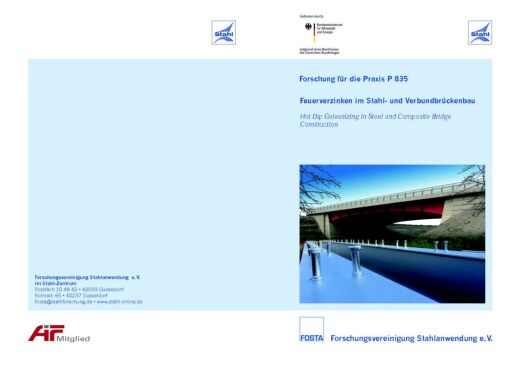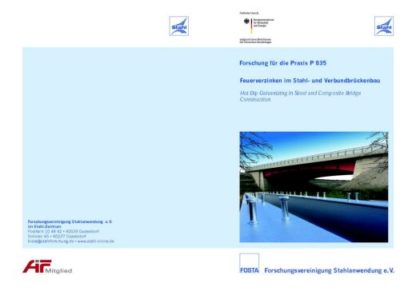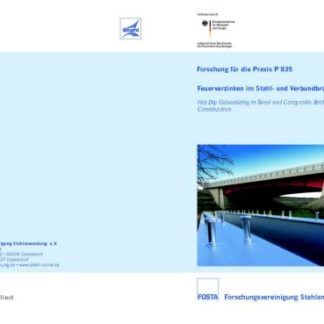Description
P 835 – Hot-dip galvanizing for steel and composite bridges
Steel and composite bridges in Germany and Europe are usually protected against corrosion by organic coatings. These coatings have a theoretical term of protection of up to 25 years. In comparison hot-dip galvanizing of steel components is a very durable and robust corrosion protection. Therefore hot-dip galvanizing has a large market share in steel building constructions. Protection periods of several decades up to 80 years or more are not uncommon. Thereby maintenance and repair works can be significantly reduced.
These ecological and economic advantages currently cannot be taken advantage of in steel and composite bridge construction. These bridges are subjected to cyclic loads and require a proof against fatigue according to DIN EN 1993-2 and DIN EN 1994-2. Since the influence of hot-dip galvanizing on the fatigue strength of the steel construction components under cyclical action of traffic load has not been sufficiently analyzed so far, hot-dip galvanized steel is currently not covered by the design standards. Therefore, the required proof cannot be provided.
The aim of the research presented here is to develop and present the elementary scientific and technical knowledge necessary on the use of hot-dip galvanization in designing steel and composite bridges.
The basis therefor were tests on the fatigue strength of typical structural details for bridge constructions in galvanized condition, partially added by comparative tests with specimens in the non-galvanized initial state. Furthermore, it was necessary to provide a proof against corrosion for the hot dip galvanizing and additionally its repair technology by thermally sprayed zinc coating, applied on transport and mounting damages, for the intended life of 100 years. Basis for this wereboth a literature review as well as various tests on protection periods, pretreatment methods and execution variants.
The result was, that hot-dip galvanizing has a significant influence on the fatigue strength, which partially also leads to a reduction of the detail categories for the proof against fatigue. The causes could be identified in the formation of the zinc coating. Comparative calculations for small and medium spanwidth bridges show only slight changes in the construction weights. At the same time the evidence for a theoretical corrosion protection period of 100 years, thus the same length as the service life of a bridge, could be provided for both the hotdip galvanized components and by metalspraying repaired locations at welded joints. For the user prepared design recommendations were provided in form of a brochure.
The holistic view of the construction and maintenance costs shows the key advantages of hot-dip galvanizing in the life cycle of bridge structures.
The research project (IGF-Nr. 351 ZBG) was carried out at Technischen Universität Dortmund at Lehrstuhl Stahlbau, at Technischen Universität Darmstadt at Staatlichen Materialprüfungsanstalt Darmstadt, Fachgebiet und Institut für Werkstoffkunde and at Institut für Korrosionsschutz Dresden GmbH. FOSTA has accompanied the research project work and has organized the project funding from the Federal Ministry of Economic Affairs and Energy through the AiF as part of the programme for promoting industrial cooperative research (IGF) in accordance with a resolution of the German parliament.
Only available in german language.
Authors:
D. Ungermann, D. Rademacher, M. Oechsner, R. Landgrebe, J. Adelmann, F. Simonsen, S. Friedrich, P. Lebelt
Published in:
2014




